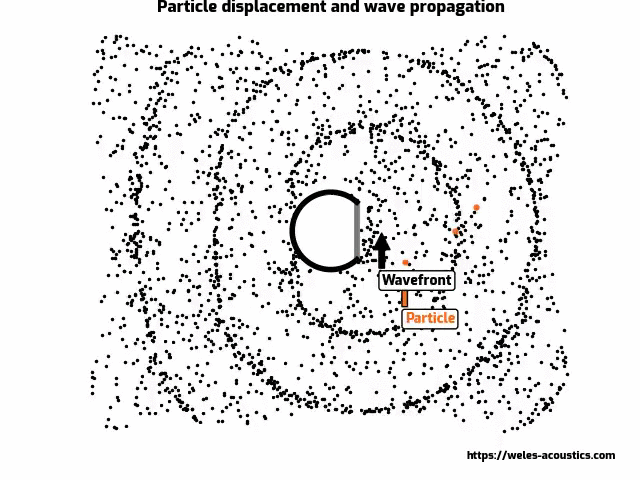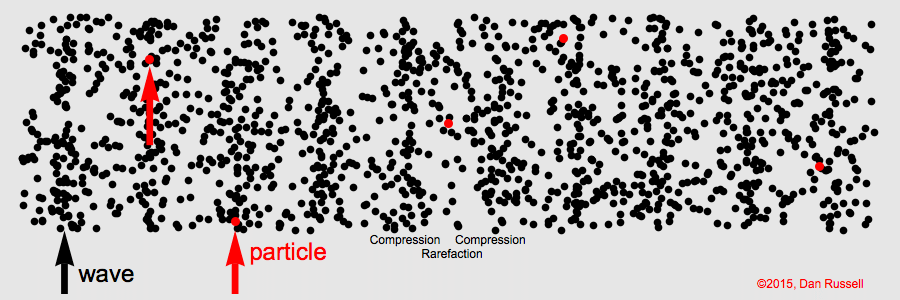Goal
Understand what a sound wave physically is.
What is a sound wave?
A sound wave is a type of mechanical wave that propagates through a medium, transferring energy from one point to another through cycles of compression and rarefaction in the medium. If you don't know what all these words mean, don't worry! That is what we aim to address here!
Seeing Sound
Before we get into the mechanics of a sound wave it can be helpful to see them.
What causes a sound wave?
Sound waves are caused by sonorous or resonating bodies, meaning actual physical surfaces are moving. Consider the string of a guitar, the reason it creates a sound is because when you pluck it, it moves. Similarly if you clap your hands, bang a drum, or eat an apple, they all make sound because they are moving back and forth, vibrating.
These vibrations cause the surface of the body to move up or down. This causes the pressure to move up or down also. If nothing is vibrating then the air will reach a steady state pressure which will appear as random motion. When something vibrates we leave steady state and the medium is said to be “excited” and causes a pattern to appear. These patterns are what we interpret as "sound". Consider the following simulation:
Try adjusting the frequency, or turning off the random motion of the air molecules. Note here there is no control for amplitude. Amplitude would be related to how much displacement the tuning fork can experience, meaning how far it can "wiggle". All we can control is how fast, the amplitude remains constant.
Questions to consider:
- For low frequencies why is it harder to see the wave propagate?
(Hint: Consider the size of the wave.)
- If we had an amplitude control would it change that?
Compression and Rarefaction
Definitions and Starting Conditions
Consider a speaker whose cone moves in and out. Suppose the cone has not yet moved and is sitting in its resting middle position, neither pulled in or pushed out. We will start the speaker in a room at steady state, meaning the air molecules have some amount of random motion and that is it. There are not yet patterns in the way the particles move. This room will be referred to as our system. A system is any situation we are considering. In this case it is how the speaker interacts with air in the room. We also assume the pressure is at steady state.
Pressure
Loosely we can view pressure as how hard something is being pushed on. Formally however pressure is equal to a force applied at right angles or normal, to an area.
The air in the room creates pressure at every point in the room. This is because the air itself pushes down creating a force on the surface area of any object we would place in the room. Scuba divers have to deal with the same problem, as you dive deeper more water is above the diver. All the water above is pushing down on the diver creating a pressure. This must be accounted for in order to dive safely. For acoustics the main take away is there is already pressure everywhere in the room.
Air molecules will randomly move around in steady state. They do not have a pattern or in other words no signal exists in the air molecules by default, some event must occur to put a pattern there. Sound is variation in pressure as we will see, and so sound has the ability to put a pattern in the way the air molecules move.
Density and Wave Speed
Another important note is that there is space between the molecules! The average amount of space between the molecules is the airs density. The air as a whole is known as a medium. A medium is a substance in which events can occur, such as a wave propagating or a chemical reaction. The density is important because it will dictate how far a particle must move in order for it to influence another particle. If the density is low then particles must move farther to influence their neighbors and this will change the wave speed. The wave will therefore take longer to move through less dense materials because the particles must move farther. There are two important notes.
It is important to note that this doesn't say anything about the losses through the material, meaning we have said nothing about any change in amplitude over time otherwise known as damping. Density certainly plays a roll but it is a complex one and will be mentioned only as needed.
Wave speed also depends on other factors that can affect the density of a medium. Temperature, Tension and elasticity can also affect density therefore, they can effect wave speed. In acoustics humidity and temperature are some concerns we may have. For example, heating systems that heat rooms unevenly could pose a problem!

Compression
Now that we understand the starting situation or the "steady state" conditions let us consider an event to excite the air. The initial event is called the transient or moment of excitement. In our case the speaker cone moves forward. As the cone moves forward it pushes the air. Air particles move through the empty space until they collide with other particles, collecting on the speaker cone as it moves. The cone will push some amount of air proportional to its size eventually coming to a stop at the limit of how far it can move.
The cones collision with the air impart energy into the air in the form of kinetic energy which is energy from being in motion. Particles will pass this energy on when they collide with other particles and hence the wave will travel outwards. The direction the wave will travel is away from the cone identically in all directions or isotropically. It will continue to travel ideally forever. However air is not great at transferring kinetic energy and will lose energy with every transfer eventually reducing to the point that the motion appears to be random once more. It also loses power because as the energy transfer travels out it also expands. This expansion happens in all directions and so it is in the shape of a sphere. The spreading out of this transfer means the further the wave must go, the more it must transfer it's already reduced energy and hence why sound gets soft so fast. This phenomenon is called the inverse square law. The compression wave moving out is known as a wave front.
The Wave and The Particle
Note there are two separate ideas.
- There is the wave that is moving through the medium.
- There is the particle that is at a specific point in the medium.
The wave is a pattern that the particles show, in this case a compression. Normally they move about randomly and do not unevenly bunch up. Hence why the speaker cone emits a signal or a pattern that contains information. This wave travels outward so long as the medium can sustain it, but what happens to the particles? Do they travel with the wave?
Remember the way the wave travels is by energy transfer. Specifically kinetic energy. Once the particle passes its energy on it may stop where is was, lose a lot of speed, or even move backwards. It depends on each collision, but in general the particles that had a lot of energy lose it and move much less. This is assuming our speaker cone does not move back and instead stays sitting forward but we know it will move back. So lets consider that case.
Rarefaction
Once the speaker cone has extended as far as it can, it then moves backwards, back to its middle position and then back even further to its farthest back position it can create. It should be noted here I am ignoring the speaker being housed, just keep in mind that when the speaker moves back it must also be pushing air behind it, which we are ignoring for simplicities sake. This backwards motion causes an area of low pressure as there is now are area open for air to move into. Energy natural flows from high to low and the air particles around the low pressure region now suddenly have somewhere to move into and so they rush in.
If the speaker were to stop here this negative cycle or rarefaction would also radiate outwards as a wave and would be a region of lower energy or density. This is because the particles that rushed into the low pressure region now leave a low pressure region where they originally were causing a ripple effect. If we were to map the result of this pressure change it would look something like this:

So when we look at a wave in our DAW, we are really looking at a graph of pressure variation. If the speaker were to come to a rest then there is no longer an energy input causing the particles to bounce against each other and there is no empty space for the particles to flow to so they would again be in steady state randomly moving about. Actually reaching this state will take time as the energy evens out around the room.
By repeating these cycles we can get our sound! Replace the speaker with any vibrating device and you will have the process! There are many details we skipped but this is the main process by which sound occurs.
Revisiting Particle Behavior
Now that we have both parts of the cycle we can see that there is a push and pull of the particles. Thus while the wave moves forward through the medium the particle instead oscillates back and forth.

Additional Simulations
Some Questions To Consider
- Say we have a speaker with a low amplitude and then a high amplitude. What would change about the speaker? What would change about particles?
- If you were above water yelling a message to someone below water why would they have a hard time hearing you? Justify your reasons with a particle behavior explanation.
- We have been very focused on air, what would be some differences we may expect from sound in other mediums such as water or helium?
- We spoke a little about density, later the concept of thickness will be introduced. Given what you know about density and thickness already how is density different than thickness?
- Given what we know about how sound is created how might we deduce a waveforms size? Can you construct a formula for it?
To support this series please consider donating via
paypalor joining the
patreon.